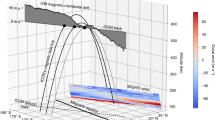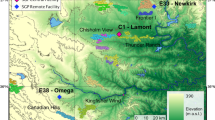Abstract
WINDS in the upper atmosphere have been measured at Adelaide, South Australia (35°S) by radio observations of drifting meteor trails, using a combined continuous wave and pulse technique1. The systematic features of the winds can be described in terms of a prevailing component and 24-, 12- and 8-h periodic components. Here we are concerned primarily with the behaviour of the prevailing component in the height range 75–105 km for the six years from June 1966 to June 1972.
This is a preview of subscription content, access via your institution
Access options
Subscribe to this journal
Receive 51 print issues and online access
$199.00 per year
only $3.90 per issue
Buy this article
- Purchase on Springer Link
- Instant access to full article PDF
Prices may be subject to local taxes which are calculated during checkout
Similar content being viewed by others
References
Weiss, A. A., and Elford, W. G., Proc. Instn Radio Engnrs. Aust., 24, 197 (1963).
Groves, G. V., J. atmos. terr. Phys., 16, 344 (1959).
Belmont, A. D., Dartt, D. G., and Nastrom, G. D., Q. Jl R. met. Soc., 100, 203 (1974).
Green, J. S. A., Phil. Trans. R. Soc., A 271, 577 (1972).
Ebel, A. Tellus, 26, 325 (1974).
Gilman, P. A., Tellus, 16, 160 (1964).
Author information
Authors and Affiliations
Rights and permissions
About this article
Cite this article
ELFORD, W. Prevailing winds in lower thermosphere. Nature 261, 123–124 (1976). https://doi.org/10.1038/261123a0
Received:
Accepted:
Issue Date:
DOI: https://doi.org/10.1038/261123a0
Comments
By submitting a comment you agree to abide by our Terms and Community Guidelines. If you find something abusive or that does not comply with our terms or guidelines please flag it as inappropriate.



